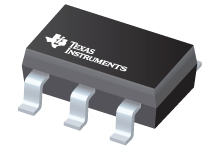Datasheet Texas Instruments TPS61070DDCR
| Manufacturer | Texas Instruments |
| Series | TPS61070 |
| Part Number | TPS61070DDCR |

Adjustable, 600-mA Switch, 90% Efficient PFM/PWM Boost Converter in ThinSOT-23 6-SOT-23-THIN -40 to 85
Datasheets
TPS6107x 90% Efficient Synchronous Boost Converter With 600-mA Switch datasheet
PDF, 1.1 Mb, Revision: E, File published: Mar 25, 2015
Extract from the document
Prices
Status
| Lifecycle Status | Active (Recommended for new designs) |
| Manufacture's Sample Availability | Yes |
Packaging
| Pin | 6 |
| Package Type | DDC |
| Industry STD Term | SOT-23-THIN |
| JEDEC Code | R-PDSO-G |
| Package QTY | 3000 |
| Carrier | LARGE T&R |
| Device Marking | AUH |
| Width (mm) | 1.6 |
| Length (mm) | 2.9 |
| Thickness (mm) | .87 |
| Pitch (mm) | .95 |
| Max Height (mm) | 1.1 |
| Mechanical Data | Download |
Parametrics
| Duty Cycle(Max) | 100 % |
| Iq(Typ) | 0.019 mA |
| Operating Temperature Range | -40 to 85 C |
| Package Group | SOT-23-THIN |
| Rating | Catalog |
| Regulated Outputs | 1 |
| Special Features | Enable,Light Load Efficiency,Load Disconnect |
| Switch Current Limit(Min) | 0.5 A |
| Switch Current Limit(Typ) | 0.7 A |
| Switching Frequency(Max) | 1440 kHz |
| Switching Frequency(Min) | 960 kHz |
| Type | Converter |
| Vin(Max) | 5.5 V |
| Vin(Min) | 0.9 V |
| Vout(Max) | 5.5 V |
| Vout(Min) | 1.8 V |
Eco Plan
| RoHS | Compliant |
Design Kits & Evaluation Modules
- Evaluation Modules & Boards: TPS61070EVM-062
TPS61070 Evaluation Module
Lifecycle Status: Active (Recommended for new designs)
Application Notes
- Single-cell Battery Discharge Characteristics Using the TPS61070 Boost ConverterPDF, 772 Kb, File published: Aug 24, 2004
This application report presents practical single-cell battery discharge characteristics in real-world application, and primarily focuses on the varying internal impedance of a battery and how that affects the battery terminal voltage. - Reducing Output Ripple Voltage of TPS61070PDF, 2.0 Mb, File published: Jun 7, 2005
This application report presents a possible solution to reduce the output ripple voltage of the TPS61070 during PFM-mode operation and primarily focuses on modifying the feedback loop response and how that affects the output ripple voltage of Bluetooth(TM) headset application with a single-cell alkaline battery. - TPS61020 Boost Converter Start-Up and PrechargePDF, 488 Kb, File published: Jan 28, 2010
The TPS61020 is a highly integrated, low-power, boost converter ideally suited for portable battery-powered equipment. To improve start-up performance from a power-limited source such as a battery, the TPS6102x family uses different steps and modes to reduce demand on the battery. This prevents the battery bus from sagging during start-up and improves start-up operation at low voltage. - How to Choose the Appropriate TPS6107x for your ApplicationPDF, 87 Kb, File published: Feb 27, 2007
- 2Q 2012 Issue Analog Applications JournalPDF, 2.4 Mb, File published: Apr 26, 2012
- Accurately measuring efficiency of ultralow-IQ devicesPDF, 254 Kb, File published: Jan 22, 2014
- Five Steps to a Good PCB Layout of the Boost ConverterPDF, 701 Kb, File published: May 3, 2016
- Minimizing Ringing at the Switch Node of a Boost ConverterPDF, 201 Kb, File published: Sep 15, 2006
The application report explains how to use proper board layout and/or a snubber to reduce high-frequency ringing at the switch node of a boost converter. - Design considerations for a resistive feedback divider in a DC/DC converterPDF, 393 Kb, File published: Apr 26, 2012
- Basic Calculation of a Boost Converter's Power Stage (Rev. C)PDF, 186 Kb, Revision: C, File published: Jan 8, 2014
This application note gives the equations to calculate the power stage of a boost converter built with an IC with integrated switch and operating in continuous conduction mode. It is not intended to give details on the functionality of a boost converter (see Reference 1) or how to compensate a converter. See the references at the end of this document if more detail is needed. - Optimizing Transient Response of Internally Compensated DC-DC Converters (Rev. A)PDF, 1.1 Mb, Revision: A, File published: May 11, 2015
- Extending the Soft Start Time Without a Soft Start Pin (Rev. B)PDF, 387 Kb, Revision: B, File published: Jun 15, 2017
- IQ: What it is what it isn’t and how to use itPDF, 198 Kb, File published: Jun 17, 2011
- Performing Accurate PFM Mode Efficiency Measurements (Rev. A)PDF, 418 Kb, Revision: A, File published: Dec 11, 2018
When performing measurements on DC-DC converters using pulse frequency modulation(PFM)or any power save mode proper care must be taken to ensure that the measurements are accurate. An accurate PFM mode efficiency measurement is critical for systems which require high efficiency at low loads such as in smart home systems tablets wearables and metering.
Model Line
Series: TPS61070 (2)
- TPS61070DDCR TPS61070DDCRG4
Manufacturer's Classification
- Semiconductors > Power Management > Non-isolated DC/DC Switching Regulator > Step-Up (Boost) > Boost Converter (Integrated Switch)
